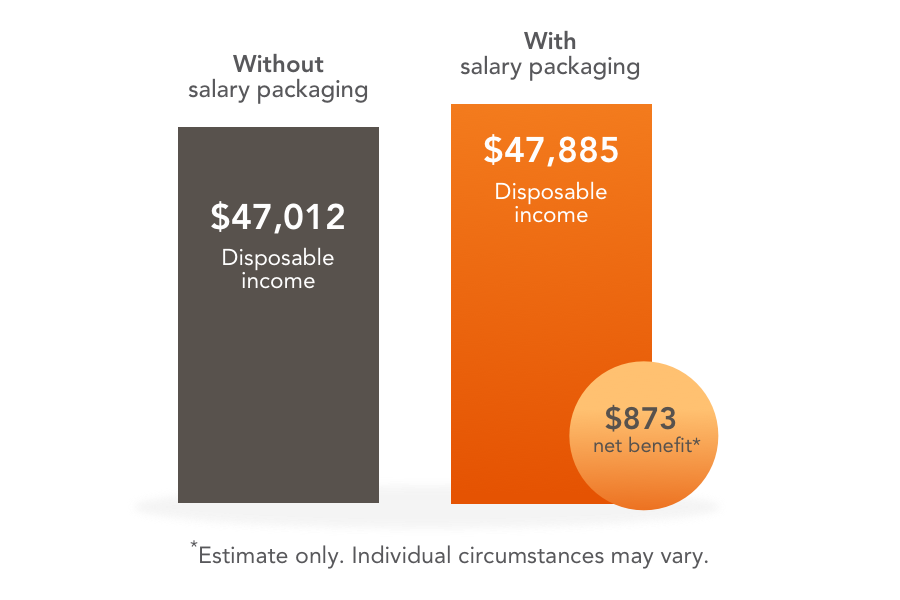Salary Packaging Superannuation
There’s a Super way you could be making your money work for you
Who can package additional super contributions?
Most employees can salary package additional superannuation contributions depending on their employer’s salary packaging policy. This salary packaging option is available to following industries:
What is the additional superannuation salary packaging benefit?
We know how superannuation generally works: your employer makes regular contributions on your behalf, and your super balance slowly grows over time.
One way to grow your nest egg a little faster is by making additional contributions – and salary packaging could be the smart way to do it.
When you salary package additional superannuation, your super is usually taxed at a concessional (before-tax) rate of 15%. This is lower than the marginal tax rate for most people.
By putting pre-tax money into your super account, the salary you receive from your employer could be reduced, lowering your annual taxable income.
This means you could save on tax, while boosting your retirement dollars!
How much can I salary package into super?
Most people can contribute up to $30,000 a year at the concessional tax rate without incurring any tax penalties. This is known as the concessional (before-tax) contributions cap.
Your concessional contributions include your before-tax salary packaged contributions, as well as the contributions your employer pays (such as your mandatory superannuation guarantee contributions) and any after-tax contributions you make and claim a tax deduction for. There are tax implications if your total concessional contributions, including your salary packaged contributions and the mandatory contributions your employer makes, exceed the concessional contributions cap.
You may be able to carry forward the unused portion of your concessional contributions cap, to increase your cap in later years. Unused cap amounts are available for a maximum of five financial years.
To find out more about superannuation contributions, the contributions caps, and tax, visit the ATO website.
How does salary packaging superannuation work?
Salary packaging can be confusing, so we’ve broken it down in the table below.
Take a person who earns $60,000 a year excluding super.
In this example, salary packaging the additional superannuation contribution produces a net benefit of $873^(in additional annual take home pay)!
| Gross Salary (Excluding Superannuation) | $60,000.00 |
| Before-Tax Voluntary Superannuation Contribution | $3,000.00 |
| Take home Pay (without packaging) | $47,012.00 |
| Take home pay (with salary packaging) | $47,885.00 |
| Net Benefit | $873.00 |
^Assumptions: All calculations are for illustrative purposes only. The estimated potential tax benefit is based on the assumption that an eligible employee salary packages the specified amount and that Input Tax Credits (ITCs) are passed on by the employer. FBT rates effective 1 July 2023 and PAYG tax rates effective 1 July 2024 have been used, average fees and charges are included. The actual administration fee that applies to you may vary depending on your employer. Tax, benefit and Medicare Levy calculations are approximate, and assume no other taxable income is received. HELP repayments and taxation surcharges are excluded. This general information doesn’t take your personal circumstances into account. Please consider whether this information is right for you before making a decision and seek professional independent tax and financial advice. Conditions and fees apply. The availability of benefits is subject to your employer’s approval.
Potential financial benefit on superannuation. Annual salary $60,000
5% Superannuation cap: $3,000

Important things to know
- Some employers may not offer salary packaging into superannuation. Speak to your employer to find out if this is an option for you and whether this will impact any other entitlements.
- If you're aged 75 years or older, you generally can't salary package superannuation.
- The value of superannuation investments can fluctuate. Before deciding to salary package additional superannuation contributions, we recommend seeking financial product advice, so you can understand any potential risks.
- Please read your superannuation fund PDS. Consider your current financial circumstances, objectives and needs, and think about how much extra you can afford to contribute before deciding whether salary packaging into superannuation is right for you.
- If you choose to salary sacrifice into superannuation, your employer needs to still contribute the mandatory Super Guarantee amount to your super account. This is calculated using your base salary and not your lowered income.
- You cannot claim a tax deduction for salary packaged superannuation contributions (which are made before-tax).
- If you're a low or middle-income earner, you may be eligible to receive a government co-contribution if you make a voluntary non-concessional (after-tax) contribution to your superannuation account. The government co-contribution is only paid on after-tax contributions. Concessional (before-tax) contributions, such as salary packaged contributions, are not eligible.
- If you're a high-income earner, you may be liable to pay Division 293 tax. This reduces the tax concession on your concessional contributions. To learn more, visit the ATO website.
- Salary packaged contributions made under an 'effective' salary sacrifice arrangement to a complying super fund are not fringe benefits and therefore are not subject to Fringe Benefits Tax. However, any salary packaged super contributions made for the benefit of an associate (such as your spouse) are a fringe benefit, as are contributions made to a non-complying super fund. To find out more, visit the ATO website.
- You can apply to release up to $15,000 of your voluntary contributions (such as salary packaged contributions) from any one financial year - and a maximum of $50,000 of eligible contributions across all years - from your super account as part of the First Home Super Saver (FHSS) Scheme. Eligibility conditions apply.
*Assumptions: The estimated potential tax benefit is based on the assumption that an eligible employee salary packages the specified amount. FBT rates effective 1 July 2023 and PAYG tax rates effective 1 July 2024 have been used and average Fees and Charges are included. The actual administration fee that applies to you may vary depending on your employer. Tax, benefit and Medicare Levy calculations are approximate, and assume no other taxable income is received. HELP repayments and taxation surcharges are excluded. This general information doesn’t take your personal circumstances into account. Please consider whether this information is right for you before making a decision and seek professional independent tax or financial advice. Conditions and fees apply, along with credit assessment criteria for lease and loan products. The availability of benefits is subject to your employer’s approval.
Things you need to know: The above information is not intended to constitute taxation or financial product advice. Your benefits and savings will vary depending on your personal objectives, financial situation and needs. We recommend you obtain independent financial advice before making any financial decisions.Eligibility criteria and terms and conditions apply. All salary packaging proposals are subject to the requirements of your employer. Administration fees will apply. The actual administration fee that applies to you may vary depending on your employer. Maxxia may pay and receive commission or rebates in connection with some services and products it provides or arranges to be provided by third parties.
Use the salary packaging calculator
We take the guesswork out of salary packaging.
